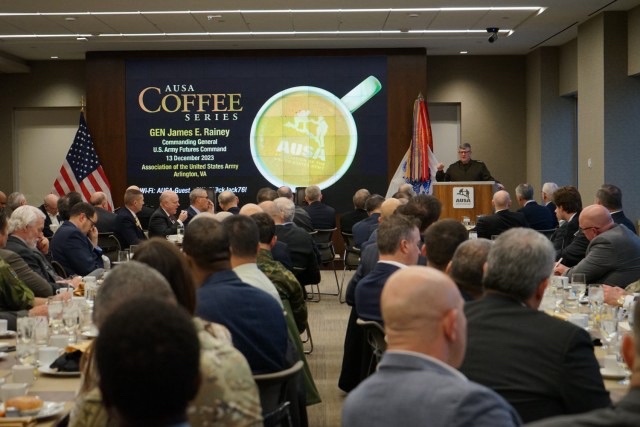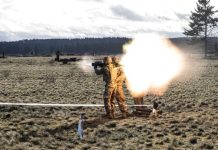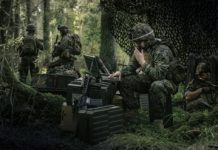
ARLINGTON, Va. — On Dec. 13, Army Futures Command Commanding General Gen. James E. Rainey spoke to Army stakeholders, supporters and media about Army transformation activities as part of an Association of the United States Army featured speaker coffee series in Arlington.
Reflecting on how modernization efforts have evolved in the five years since AFC’s founding, Rainey shared that the command’s scope has grown to encompass “overall responsibility for the entire transformation portfolio.”
“I remain convinced that it was a bold move and it was the right move for the Army to stand up Army Futures Command,” Rainey said.
He emphasized that the command works hand-in-hand with Army Training and Doctrine Command, Army Materiel Command, Army Forces Command and the Office of the United States Assistant Secretary of the Army for Acquisition, Logistics and Technology to create, evaluate and develop new concepts, systems and equipment for the Army and Joint Force, with essential support from Congress.
In looking ahead to priorities for 2024 and beyond, Rainey highlighted the need to continue investing strategically in command and control and defensive measures, given their weighty importance in shaping tomorrow’s warfighting landscape.
“We’ve got to keep getting better, get lighter,” Rainey said of current network capabilities.
AFC is also looking at ways to make data more available and user-friendly as part of next-generation C2 efforts, and Rainey acknowledged that the future force will require commanders, Soldiers and Department of the Army civilians alike to be data literate or data fluent.
“We have the potential to reinvent and really develop a data-centric command and control system,” he said, stressing the need for a more “complex, adaptive, systems-to-systems approach to warfare.”
“I believe that if we move to a truly data-centric approach to fighting, it’ll revolutionize most of warfare, primarily deterrent value. Somebody being willing to attack into the face of a lethal, data-driven capability, it would be pretty foolish.”
According to Rainey, future deterrence and defense measures will include advanced air and missile defense technologies and integrated offensive and defensive fires, along with measures that improve adaptability and endurance of formations.
“We’ve got to preserve our people and our ability to do maneuver warfare,” he said.
Rainey underscored the criticality of maintaining and strengthening Soldier lethality, in part by leveraging human machine integrated formations, or HMIF, to optimize battlefield outcomes.
“Our best weapon system we have is still the Soldier; best formation we have is still the rifle squad.”
Protecting Soldiers in combat and further enabling them to do what only humans can do will require smart investments in transformational machine capabilities, particularly those that capitalize on mobility and can increase lethality and survivability, Rainey explained.
“Autonomous and robotic systems are going to disrupt the land domain, starting now,” Rainey said, detailing how technology available today can help mitigate risks to Soldiers by placing robots in traditionally higher risk positions.
“We have the ability and I think the moral responsibility to not trade blood for first contact with the enemy,” he asserted.
Rainey shared that the Army has already started to prototype an HMIF light infantry platoon at Fort Moore, Georgia, as well as a heavy infantry version at the National Training Center, California. The formations will incorporate robots and configurable payloads designed to augment human capabilities in modern but realistic ways.
“If you take robots and try and replace humans or combat vehicles, you’re on a vision quest, and it’s going to take a long time. If you take humans and robots and put them together in a coherent formation, you start solving all the problems in both directions,” Rainey said.
With continuous transformation as a chief Army priority, AFC has increased its experimentation and analytic efforts by approximately 20 percent in 2023, Rainey reported. Upcoming experiments include the joint, multinational Project Convergence Capstone 4, which will take place at Camp Pendleton and Fort Irwin, California, in early spring 2024.
The command is also developing the Army’s next warfighting concept that will inform future planning actions and address institutional challenges. The draft concept has drawn insights from future study initiatives and current conflicts like those taking place in Ukraine and Gaza. This includes honing the Army’s ability to “look at things that are happening in the world and move into a rapid acquisition of capability,” Rainey said.
In addition, AFC is conducting a tactical fires study and recently reached full operational capability of its Contested Logistics Cross-Functional Team, which is focused on predictive logistics, alternative power, demand reduction and autonomous and robotic resupply.
The command continues to support enduring priorities as well, such as the Army’ signature modernization efforts, which fall under the categories of long-range precision fires, next generation combat vehicles, future vertical lift, network, air and missile defense, and Soldier lethality.
During the coffee series conversation, Rainey spoke to audience members, including industry representatives, about the importance of supporting support rapid acquisition – “the need to transform, be agile, be adaptive inside the next two years” — as part of the Army’s overall transformation effort, noting that technologies such as loitering munitions and company-level unmanned aircraft systems could provide pivotal effects. He explained that the Army is working to incorporate such capabilities within a doctrine, organization, training, materiel, leadership and education, personnel, facilities and policy framework, to ensure appropriate training, sustainment and leader development. At the same time, the Army is also eyeing frameworks for 2025-2030 and leap-ahead capabilities for 2030-2040.
“That’s the real opportunity, where things are fundamentally going to change,” Rainey said of the latter.
By Maureena Thompson, Army Futures Command
You can skip to the end and leave a response. Pinging is currently not allowed.








